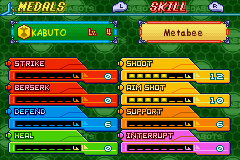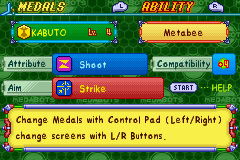Stats
There are a large number of stats and parameters used in the Medarot video games. They can be broken up into two main categories: stats present on Medals and stats present on parts.
In-depth information by game[edit]
(Games with identical battle mechanics are grouped together.)
- Stats in Medarot 1
- Stats in Medarot 2 / R
- Stats in Medarot 3 / 4
- Stats in Medarot Navi
- Stats in Medarot 5
- Stats in Medarot G / AX
- Stats in Medarot 2 Core / Shingata
- Stats in Medarot Brave
- Stats in Medarot DS
- Stats in Medarot 7
- Stats in Medarot Dual
- Stats in Medarot 8
- Stats in Medarot 9
- Stats in Medarot Girls Mission
- Stats in Medarot S
Medal stats[edit]
The Medal is the part of the Medarot that gains levels and becomes stronger over time.
Level[edit]
Medals have a numerical level, which can be increased in most games by collecting experience points from Robottles. The Medal's level affects its base accuracy and damage, as well as deciding when it evolves and when it learns its Medaforce abilities. Some games (Medarot DS and later RPGs) do not use experience points, and instead use the combined levels of all of the Medal's skills as the Medal's overall level.
Skills and skill levels[edit]

The main stats that affects a Medal's performance in battle are its skill levels (じゅくれんど, 熟練度, or スキルレベル in Japanese), which can be increased by repeatedly using parts with matching skills. Having a higher skill level means that parts using the skill will be faster, more accurate, or more powerful.
There are 11 skills used throughout the Medarot series:
- Strike (なぐる)
- Berserk (がむしゃら)
- Shoot (うつ)
- Snipe (ねらいうつ), a.k.a. "Aim Shot" in official English releases.
- Protect (まもる or えんご), a.k.a. "Defend"
- Heal (なおす or かいふく)
- Support (おうえん or たすける)
- Disrupt (ぼうがい), a.k.a. "Interrupt"
- Set-up (せっち or しかける)
- Special (とくしゅ)
- Other (そのほか)
Different games use different skills. The games featuring the most skill categories are Medarot 3, 4, 5, and Navi, which include all of them except "Other". From Medarot 7 onwards, the Shoot, Snipe, Strike, and Berserk skill levels were combined into "Shooting" (しゃげき) and "Melee" (かくとう) to make leveling up easier.
Some games (Medarot 3, 4, Navi, DS, 7, 8, and 9) limit each Medal to only being able to gain levels in 3 skills. (For example, in Medarot 3 the Kabuto Medal can only use Shoot, Snipe, and Set-up skills, and the rest of its skill levels are permanently locked at 0 unless it's equipped with a Medalia.)
Attribute or compatibility[edit]

In the GB/GBA-era games, the Medal's attribute (ぞくせい or 属性) is the category of parts that the Medal is most compatible with. Equipping compatible parts gives the Medal a bonus to the success rate of all of its attacks and actions, and the amount it increases depends on the Medal's "compatibility bonus" (listed as "compatibility" (あいしょう or 相性) on its stat pages). Medals with fewer available compatible parts tend to have a higher compatibility bonus value to compensate.
From Medarot DS onwards, compatibility is determined by the part's skills (for head and arm parts) and leg type (for leg parts).
Nature, Target, or Robottle style[edit]
A Medal's nature (せいかく or 性格) determines which opponents or parts it is more likely to target with its actions, for example "parts with high HP" or "leg parts". Natures are usually predetermined for each Medal, but in Medarot 1 it was possible to influence the Medal's nature over time by having it equip different kind of parts (tracked as Attack (こうげき), Defense (ぼうぎょ), and Special (とくしゅ) on its stat page).
In Medarot 2 Core and Shingata Medarot, the system was simplified so that Medals target parts with a specific skill, listed on the stat page as "Target" (ターゲット), or "Aim" in the English release. From Medarot 7 onwards, Medal natures can have additional effects, such as reducing the damage the Medarot takes or increasing its charge speed. Since Medarot 8 removed the random targeting aspect from Robottles, Medal nature was renamed to "Robottle style" (ロボトルスタイル) but the effects remained unchanged from 7.
Medaforces[edit]
Introduced in Medarot 2, Medaforces are special attacks or actions that Medarots can use by depleting their Medaforce gauge or Charge gauge. Depending on the game, each Medal can learn between 1 and 3 Medaforces as they level up, and the specific Medaforces learned depend on the type of Medal.
Medalias[edit]
Introduced in Medarot 3, Medalias are small jewels that can be equipped to a Medal to improve its abilities. Depending on the game, Medals can equip 1 or up to 3 different Medalias. In Medarot 3 and 4, they can be used to give Medals skill levels in skills that they normally can't use, and can gain skill levels over time along with the Medal.
Leader skills[edit]
Present in Medarot 5 and Medarot 9, leader skills are powerful extra effects that affect the entire team when the Medal is chosen as the leader Medarot in a battle. In Medarot 5, leader skills are unlocked when the Medal is used as the leader Medarot in 100 battles, but in Medarot 9 they are available from the start and can be influenced by the Medalias the Medal has equipped.
Part stats[edit]
Unlike Medals, the stats on parts are all predetermined and cannot be improved over time. They can be broken up into two categories: stats present on head/arm parts, and stats present on leg parts.
Head and arm parts[edit]
- Action (行動/わざ) - The attack or ability that the part performs in battle.
- Skill (行動/スキル) - Determines which of the Medal's skill levels the part uses and how it behaves in battle.
- Attribute (ぞくせい/属性) - The category that the part falls into, used for determining Medal compatibility.
- Armor (そうこう/装甲) - The part's HP. The part is destroyed when it's armor reaches 0.
- Power (いりょく/威力) - Determines the part's attack power or the strenth of its effect.
- Success (せいこう/成功), a.k.a. "rate of success" or R.O.S. - Determines the part's accuracy and/or its likelihood of landing a critical hit.
- Charge (じゅうてん/充填) - Determines the wait time between when the action is selected and when it's performed.
- Cooldown (ねつりょう/ほうねつ/れいきゃく/冷却), a.k.a. Radiation - Determines the wait time between when the action is performed and when the next action can be selected.
- Uses (かいすう/回数) - The number of times a head part can be used per battle.
- Target (対象) and Range (射程) - Used in Medarot Navi, which uses a grid-based battle system.
- Action Point cost (消費AP) - Used in Medarot Navi. Moving or using actions takes AP, which regenerates every turn.
- Pierce (かんつう/貫通) - Determines whether or not the part's effect can carry over onto additional parts, usually marked as a symbol next to its Power.
Leg part stats[edit]
- Attribute (ぞくせい/属性) - The category that the part falls into, used for determining Medal compatibility.
- Leg type - Determines the terrain types that the leg parts work best on.
- Leg ability (とくせい) - A passive ability that affects the user in battle. (Introduced in Medarot 8.)
- Armor (そうこう/装甲) - The part's HP. The part is destroyed when it's armor reaches 0.
- Speed(すいしん/推進), a.k.a. Propulsion - Affects the Medarot's movement speed and the strength of its heavy attacks.
- Mobility (きどう/起動), a.k.a. Evasion - Affects the Medarot's ability to dodge attacks.
- Defense (ぼうぎょ/防御) - Affects the amount of damage the Medarot takes.
- Melee (かくとう/格闘/きんせつ), a.k.a. Proximity - Affects the strength of the Medarot's melee/close-range attacks.
- Shooting (しゃげき/射撃/えんかく), a.k.a. Remoteness - Affects the strength of the Medarot's shooting/long range attacks.
- Scan (さくてき) and Conceal (いんぺい) - Affects the Medarots effectiveness at using Scan and Conceal actions.